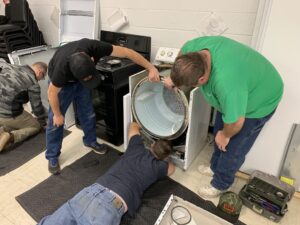Maintaining a properly functioning oven is crucial for any home cook or baker. An oven that overheats can not only ruin your meals but also pose safety risks. In this article, we will explore the common causes of oven overheating and discuss how to diagnose and fix these issues. Understanding the temperature regulation system in your oven is essential for preventing future overheating incidents.
Common Causes of Oven Overheating
There are several factors that can cause an oven to overheat. One common cause is a faulty thermostat. The thermostat is responsible for regulating the temperature inside the oven. If it malfunctions, it may not accurately measure the temperature, leading to overheating.
Another cause of oven overheating is a malfunctioning heating element. The heating element is responsible for generating heat inside the oven. If it becomes damaged or worn out, it may not distribute heat evenly, causing certain areas of the oven to overheat.
A damaged oven door seal can also lead to overheating. The door seal is designed to keep heat inside the oven and prevent it from escaping. If it becomes damaged or worn out, heat can escape, causing the oven to work harder and overheat.
Understanding the Temperature Regulation System in Your Oven
To understand why an oven overheats, it’s important to understand how ovens regulate temperature. Most ovens have a temperature sensor that measures the internal temperature and sends signals to the thermostat. The thermostat then adjusts the heat output accordingly to maintain a consistent temperature.
Maintaining a consistent temperature is crucial for cooking. Different recipes require specific temperatures for optimal results. If an oven overheats, it can lead to uneven cooking or even burning of the food.
What Happens When Your Oven Overheats?
When an oven overheats, several consequences can occur. Firstly, your food may not cook evenly. Certain areas of the food may be overcooked while others remain undercooked. This can result in a less than desirable taste and texture.
Secondly, an overheating oven can pose safety risks. The excessive heat can cause the oven to malfunction or even catch fire. This can be dangerous for both you and your home.
Signs That Your Oven is Overheating
There are several signs that indicate your oven is overheating. One common sign is when your food cooks faster than expected. If you find that your food is consistently cooking faster than the recipe suggests, it may be a sign that your oven is running too hot.
Another sign is when the outside of your oven feels excessively hot to the touch. While it’s normal for the oven to generate heat during cooking, it should not feel scorching hot on the outside. If you notice this, it may indicate that your oven is overheating.
Additionally, if you see smoke or smell burning odors coming from your oven, it’s a clear sign of overheating. These signs should not be ignored and should be addressed promptly to prevent further damage.
Overheating Due to a Faulty Thermostat
A faulty thermostat is a common cause of oven overheating. To diagnose this issue, you can use an oven thermometer to compare the temperature displayed on the oven’s control panel with the actual temperature inside the oven. If there is a significant difference, it may indicate a faulty thermostat.
To fix this issue, you will need to replace the thermostat. It’s recommended to seek professional help for this repair, as working with electrical components can be dangerous if you’re not experienced.
Overheating Due to a Malfunctioning Heating Element
A malfunctioning heating element can also cause an oven to overheat. To diagnose this issue, visually inspect the heating element for any signs of damage or wear. If you notice any abnormalities, it may indicate a malfunctioning heating element.
To fix this issue, you will need to replace the heating element. Again, it’s best to seek professional help for this repair to ensure it is done safely and correctly.
Overheating Due to a Damaged Oven Door Seal
A damaged oven door seal can cause heat to escape from the oven, leading to overheating. To diagnose this issue, visually inspect the door seal for any signs of damage or wear. If you notice any gaps or tears in the seal, it may be the cause of your oven overheating.
To fix this issue, you will need to replace the oven door seal. This is a relatively simple repair that can be done by yourself. You can purchase a replacement seal from an appliance parts store or online.
Overheating Due to a Dirty Oven
A dirty oven can also cause overheating. Over time, grease and food particles can accumulate inside the oven, blocking airflow and causing the oven to work harder to maintain the desired temperature.
To prevent overheating due to a dirty oven, it’s important to regularly clean your oven. You can use a mixture of baking soda and water or a commercial oven cleaner to remove grease and food residue. Be sure to follow the manufacturer’s instructions when using any cleaning products.
Overheating Due to Incorrect Oven Settings
Incorrect oven settings can also cause an oven to overheat. It’s important to set the oven temperature and cooking time according to the recipe instructions. If you set the temperature too high or cook for too long, it can lead to overheating.
To prevent overheating due to incorrect oven settings, always double-check the recipe instructions before cooking. Use an oven thermometer to ensure that the temperature inside the oven matches the desired temperature.
How to Fix an Overheating Oven
To fix an overheating oven, you will need to identify and address the specific cause of the issue. This may involve replacing a faulty thermostat, heating element, or oven door seal. It’s important to seek professional help if you’re not experienced in working with electrical components.
If you’re unsure of the cause of the overheating or if you’re uncomfortable with making the repairs yourself, it’s best to contact a professional appliance repair technician. They will have the knowledge and expertise to diagnose and fix the issue safely and effectively.
What Are the Common Causes of Oven Overheating and How Can Heating Elements Be Repaired?
Oven overheating commonly occurs due to a faulty thermostat or a malfunctioning heating element. Repairing heating elements tutorial can help fix this issue. To repair the heating element, first, unplug the oven and remove the element. Check for any visible damage and replace it if necessary.
Preventing Oven Overheating: Maintenance Tips and Tricks
Preventing oven overheating starts with regular maintenance. Here are some tips to keep your oven in good working condition:
1. Clean your oven regularly to remove grease and food residue that can block airflow.
2. Check the oven door seal for any signs of damage or wear and replace it if necessary.
3. Use an oven thermometer to ensure that the temperature inside the oven matches the desired temperature.
4. Follow recipe instructions for setting the oven temperature and cooking time.
5. Avoid placing foil or other objects on the bottom of the oven, as they can disrupt airflow and cause overheating.
Maintaining a properly functioning oven is essential for any home cook or baker. Oven overheating can lead to ruined meals and safety risks. By understanding the common causes of oven overheating and taking preventative measures, you can ensure that your oven operates at its optimal level. Regular maintenance and prompt repairs are key to preventing future overheating incidents. Take action now to keep your oven in top shape and enjoy delicious meals without any worries.



